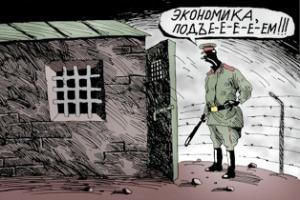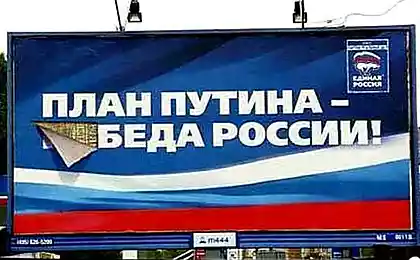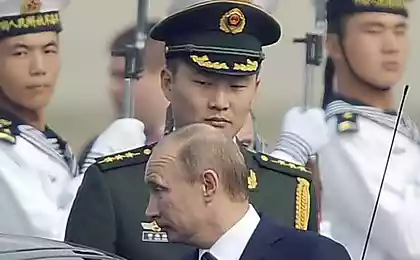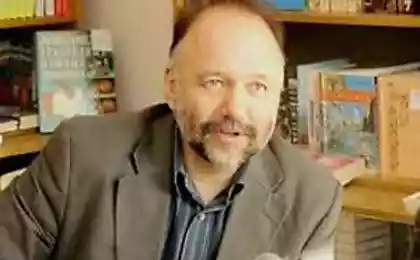1361
Putin's reforms. Deep peak?

April 8, 2014 the Ministry of Economic Development of Russia lowered the forecast of GDP growth in Russia in 2014 with 2, 5 and 1, 1 percent. At the same time Deputy Economic Development Minister Andrei Klepach said that this growth rate will be able to provide only if the state will take measures to support the environment. Otherwise, GDP growth will drop to 0, 5 percent.
According Klepach, these projections do not take into account the "shock scenarios relating to sanctions, with some serious upheavals in the global economy." The deputy minister also said that the economic growth forecast for 2014 is lowered as due to the increased outflow of capital abroad, as well as to the reduction of hydrocarbon exports to the EU and Ukraine
Analysis. Trends in the development of the Russian economy in the last 3 years testify to the development of systemic crises that undermine the rating authorities, and require compensatory mechanisms hold rating and prevent the growth of social tension.
The manifestation of the crisis in the Russian economy became apparent by the end of 2012, giving a reason to say about their system. Slower growth occurred during this period on the back of high oil prices and the intensity of the development project of the Customs Union. Final results of the growth of the Russian economy were significantly worse than the most pessimistic forecasts of government officials and the Ministry of Economy (3, 4% against the forecasted 4, 2-4, 3%). Thus there was deterioration in GDP growth and increased degradation of the structure of the economy.
A key factor is the fact that economic growth in Russia is down due to high energy prices. By the end of 2012 the average price of Brent blend updated their absolute historical maximum (in nominal terms) and reached the level of $ 111. Per barrel. The growth rate of the Russian economy declined from 4, 7-4, 9% in the first months of 2012 to a record 1, 9% in November, that the rollback economy to that of the autumn of 2010, when oil prices fluctuated in the range of $ 72¬78 . per barrel.
By the end of 2012 to the fore the following problems of the Russian economy:
• high level of bribe tax;
• high level of monopolization;
• a critical rise in prices of natural monopolies, fuel and utilities (12-17%, which is 2-3 times higher than the rate of inflation);
• shortage of available long-term investment of resources.
Thus, the favorable external economic environment and record high prices for major export commodities, which provide over 70% of Russian budget revenues and over 85% of the inflow of export earnings, could not reverse the negative pressure from the structural imbalances in the economy and the poor quality of public administration. < br />
Russian non-primary enterprise carried in extremely nizkoplatezhesposobnogo domestic demand high overhead, which have become incompatible with the exercise of any economic activity not related to the extraction of raw materials, trade, brokering and financial speculation.
If in 2010 the total amount of temporarily idle resources of the federal government accounts with the Bank of Russia and the commercial banks reached 5 962 trillion. rubles, in 2011, their volume increased to 7 748 trillion. rubles, and in 2012 against the backdrop of record high annual average oil prices this figure was 8,824 trillion. This is equivalent to 73% of Russia's federal budget, or 13, 8% of GDP in 2012. Thus, despite the 1, 5-fold increase in the size of the "safety cushion", obtained by artificial withdrawal from the economy of 3-4% of GDP per year, the growth rate Economy tightened to 1 44-fold - 4 9 3 4%. At that official Moscow continued to maintain a deficit of money and credit available.
2013 the growth rate of the Russian economy also remained low. First of all, reduce the rate of growth of real wages and real incomes.
In III quarter seasonally adjusted GDP decreased by 0, 2%. In comparison with the 11 months of 2012, according to the Ministry of Economic Development, the economy grew by only 1 to 3%. By the end, the mayor officially recognized: the stagnation caused not only by external factors. Acceleration of developed economies in the second half did not affect the dynamics of the Russian economy. Unreliable base effect (high growth in the first half of 2012 and the slowdown in the second), which gave reason to expect a brisk pace of growth in the second half of 2013.
Already in 2014, the GDP growth of the Russian Federation, according to the head of the Economic Development Ministry Alexei Ulyukayev, may fall and be only 1, 8-1, 9%. Falling investment has an impact on both external and internal investors. As a result of the rise of capital outflows. If the outflow of capital in 2014 will amount to 100 billion dollars, the GDP growth will be around 0, 6%. A similar forecast yields and president of Sberbank of Russia German Gref, and the bank HSBC, which has lowered the forecast growth of the Russian economy in 2014 from 2% to 0 and 6%. Estimated MER RF, capital outflows in the first quarter of 2014 is estimated in the $ 60 billion. For comparison, the entire 2013 capital outflows amounted to 62 billion dollars 7.
Thus, only a single peak in the case of capital outflows in the first quarter, the figure for the year will amount to 100 billion. However, in the case of external pressure and support the conservation of volumes of capital flight, reduction of GDP may be more significant. Deputy Minister of Economic Development of Russia Sergey Belyakov said on March 16 that the economy takes the telltale signs of the crisis.
In early March 2014 Minister of Economic Development of the Russian Federation Alexei Ulyukayev said the feasibility to increase the federal budget deficit for 2014 by about 1% of GDP. According to him, this is compensated by the high capital outflow.
HSBC Bank indicates that the indicators of economic activity in the Russian Federation remain disappointing. Negative growth in annual terms, marked by industry and investment in fixed assets in January, as well as PMI index values indicate a continuation of stagnation in February. Expectations of a recovery in investment and export demand in 2014 were undermined by increasing geopolitical risks in the region and the relatively weak economic growth in China, a key buyer of Russian commodities.
The rapid depreciation of the Russian national currency in January-February, carries the risk of transition to higher inflation, which, obviously, for the year will be 5, 2¬5, 5%.
The federal budget, cut all non-social spending by 5%, also shifts part of the commitments to the following years due to scarcity of funds. Since the Finance Ministry was faced with lost revenue by the end of 2013, he was sent to cover the deficit all were due to transfer in the reserve fund oil and gas revenues in the amount of 900 billion rubles. More about 1 trillion rubles. received less regions: income tax on profit instead of the planned growth of 12-15% down to 15%. In this regional budgets for 2014 made assuming growth of income tax revenue by 15%, federal - on the basis of economic growth of 3% and the price of oil to $ 101. Per barrel.
The price of oil, estimates of Russian representatives of the banking sector to balance the budget in 2014 will rise to $ 115. From the current $ 110. Because of such a strong dependence on oil authorities are forced to seek additional sources of funding.
Despite the decline in demand for loans by enterprises, resources are expensive, encouraging banks to lend to households. Hard action of the Central Bank forced banks to increase liquidity cushion, and the population - take deposits. According to estimates of representatives of the Russian banking system, the deterioration of the economic situation will further worsen the quality of the assets on bank balance sheets, to launch the second wave of "cuts" in the sector. As a result, in 2014 the Russian economy expects a full-blown crisis, which in scale is still less than the 2008-2009 crisis.
Russian exports are largely dependent on global demand for energy and metals. Although it is expected that the pace of global economic growth this year will be higher than in 2013, they will be due mainly to the success of the developed countries, while developing markets will lag somewhat behind. However, it is the emerging markets, especially China, provide the growing demand for raw materials, which is reflected in the increasing correlation between economic growth in China and Russia. Thus, the expected slowdown in China would harm Russian exports.
The fundamental cause of the crisis in the Russian Federation - is to reduce the impact of monetary stimulus on the economy. If earlier the government was guided by the doubling of GDP through a permanent increase in the money supply, at the present time, this policy has lost its effectiveness, as in the work of business increased shadowing factor, "kickbacks" and "schemes". The result was the inhibition of growth of industrial production to 0, 1%, and falling investment in buildings, structures and other fixed assets at 1, 6% a year. At the same time, building a business on a "rollback" has led to a drop in the effectiveness of competition and economic decisions, as well as an end to economic growth natural methods.
In the international rating agency Standard & Poor's believed that Russia's economic growth is slowing down not only due to the increasing unfavorable external economic environment, but also due to the exhaustion of the capacity of the existing model of economic growth.
According to our estimates, in the next 1, 5-2 years will increase in the next stage of economic imbalances in the yield of households in the territory of the Russian Federation. This will generate an even greater gap between the rich and the poor.
Thus, the number of people with incomes below the subsistence minimum in Russia according to Rosstat, in 2013 increased by 300 million, accounting for 15, 9 million people (11, 1 percent of the total population). For comparison, in 2012 the poor were 10, 9 percent of the population.
This approach, according to our estimates, may lead to future growing dissatisfaction among the Russian political elite, some of which will be excluded from participation in profitable projects, and get under the international sanctions imposed in response to the occupation of the ARC.
Forecasts include the probability of a Russian apical coup, based on will lie also an economic factor in the long term of 3 years with a probability of 20% in the case of saving the current Western policy toward the Kremlin's actions and "moderate" economic sanctions.
Analysis of the situation in the agriculture of the Russian Federation also shows that there are serious imbalances and the crisis in the agricultural sector, with signs of a systemic crisis.
Imports of food products and agricultural products to the Russian Federation still exceed exports of these products. Export growth rate exceeds the growth rate of imports, but their volumes do not allow us to say that these figures are compared in at least the medium term. So, in 2010, the Russian Federation exported foodstuffs and agricultural raw materials in the amount of 8, 8 billion. Dollars and imported 4 times more - worth $ 36, 4 billion. Dollars. In 2013, Russia was able to improve the situation in this group of products, but it still remained critical. Exports amounted to 16, 2 billion. Dollars, while imports of 43, 1 billion. Dollars.
For some product groups the dependence of Russia on imported products is critical. According to the academician-secretary of the Russian Academy of Agricultural Sciences A. Altukhova, the proportion of Russian meat and meat products, and milk and dairy products in the total resources of the Russian Federation is below the threshold level Food Security Doctrine of the Russian Federation. For meat and meat products, the figure is 77, 4% (with a threshold of 85%), milk and dairy products - 77, 1% (with a threshold of 90%). Thus in 2011 the proportion of milk and dairy products continually decreases (decrease of 2, 8%). Near threshold balances the corresponding figure for vegetable oil. And if in 2013, when the trend of falling, he still was above the threshold of 1, 5%, in 2010 and 2011 - below.
In 2013 there was an increase of the index of agricultural production at the level of 6, 2%. However, in 2012, observed drawdown at 4, 8%. That is, growth in the two years was only 1, 4%.
In 2013, for the first time since 2011 dropped the level of the physical layer of fixed capital investment in agriculture. This figure was 4%, which does not correspond to the planned growth of the corresponding program by 4%. in general, in 2008-2012, investment in agriculture fell by 9% with an overall growth in the economy by 19%.
Note that on this background significantly reduced the profitability of agricultural production, which in 2013 was slightly lower than the crisis of 2009 - 9, 3%. This is despite the fact that even in 2012, profitability was 12, 1%, and in 2011 - 11, 8%. In reality, the profitability figures may be even lower. At least on "false information that gets MOA" the producer said.
The most dangerous trend for Russia is to develop competitive industries through the creation of enterprises, depending on subsidies. Starting in 2010, the Russian Federation has been actively subsidize agriculture - at the level of 135 - 138 billion. Rubles annually. For comparison, in 2007, subsidies were paid at the level of 56 billion. Rubles, in 2008 - 99, 7 billion, in 2009 - 112 billion. Rubles. Thus began actively falling profitability. If in 2007 the profitability without subsidies was 8, 1%, whereas in 2009, when the subsidies exceeded $ 100 billion. Rubles, profitability without subsidies amounted to 3, 3%. In 2010, this figure was -5, 4% and 2013 - 1 and 7%. Only in 2012 was recorded a positive indicator of profitability without subsidies at 1, 4%. All other years after the program began actively subsidizing Russian agriculture marked by negative rates of profitability without subsidies. At the same time, to conduct such a policy in the period of 2005 - 2008 years of profitability without subsidies was positive and varied at 2, 1-8, 1%.
In the near future is not planned to minimize the scale of the program subsidies. Conversely subsidies is planned to increase in the future in order to increase production. We believe that the implementation of this strategy, the real profitability of agriculture will not grow and remain negative, although a few of the Russian Federation will be able to increase production.
At the same time, total dependence on agriculture subsidies will make it completely uncompetitive living solely through public support. In such circumstances, any reduction in subsidies to the industry will lead to massive bankruptcies and a significant reduction in production. Thus, over the past four years, the federal government was able to create the conditions under which any significant drawdown of the world market, which would entail a blow to the economy of the Russian Federation and a further major revision of fiscal policy can lead to total collapse of agriculture in the country and pose a significant threat food security of the state.
In such circumstances, the only appropriate strategy for Russia is increasing the efficiency of agriculture, primarily in the plant, where you can expect faster results. Obviously, such a strategy would not be linked to the technological modernization of the agricultural machinery. In 2013, the Sub-program "Technical and technological modernization, innovation development" has failed. Its implementation was 23%. Purchase of tractors for the year decreased by 23, 6% of combine harvesters by 12, 4%, forage harvesters by 40, 5%. Thus, the main focus will be to increase yields. In this regard, we believe that in the coming years, the federal government of the Russian Federation will attempt to market a full production of GM plants. In the first case of soybeans and corn. According to our estimates, in spite of the public tough stance the country's leadership regarding GMOs in Russia, the real policy will be aimed at further expansion of full legal cultivation of GM plants with the simultaneous creation of conditions for organic farming. Under such conditions, the Russian Federation will be able to partially stop the above negative trends in crop production, as well as strengthen the direction of livestock.
Conclusions:
1. Last 3 years in the Russian economy is the development of a systemic crisis.
2. favorable global environment 2012-2013
Funny and silly signs beauty salons
The UN Security Council URGES RUSSIA TO STOP tellin 'UKRAINIAN Tale "























